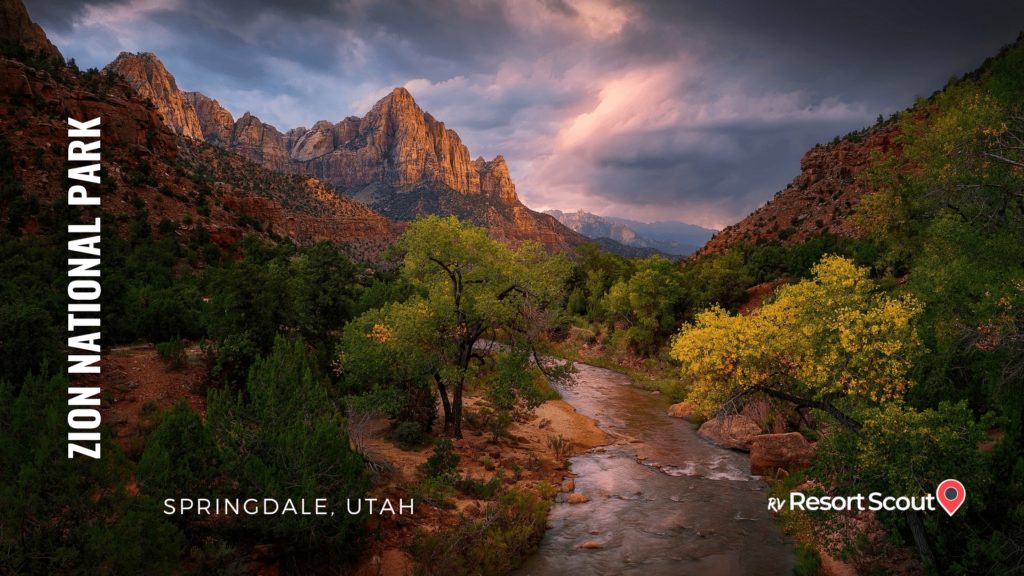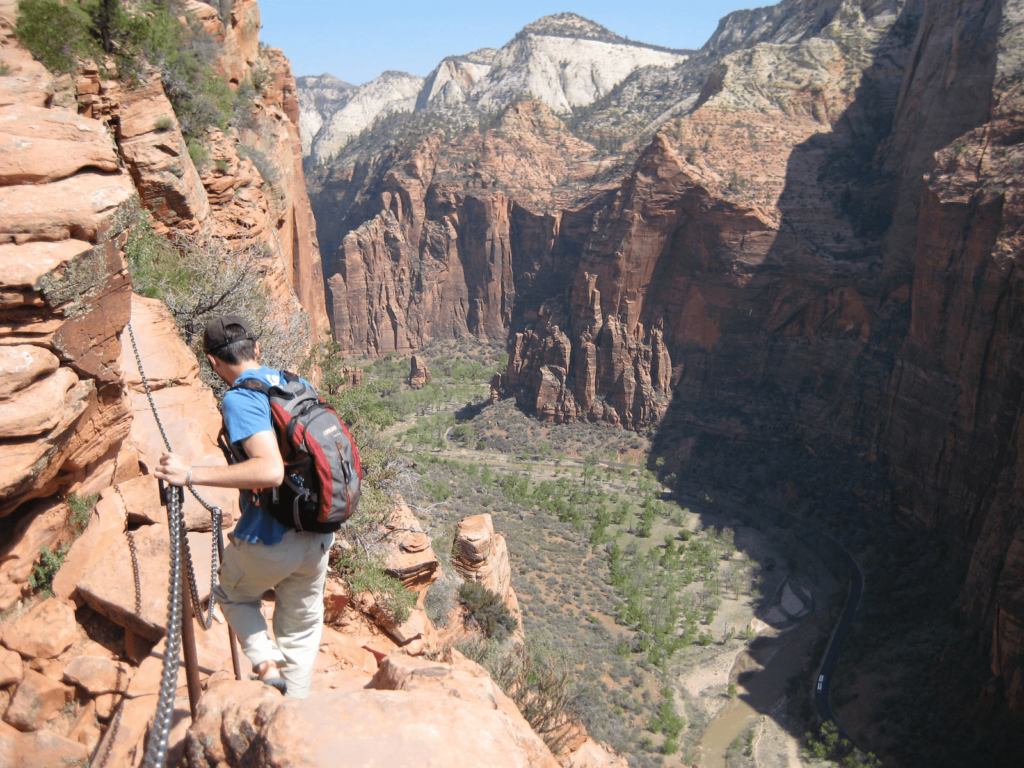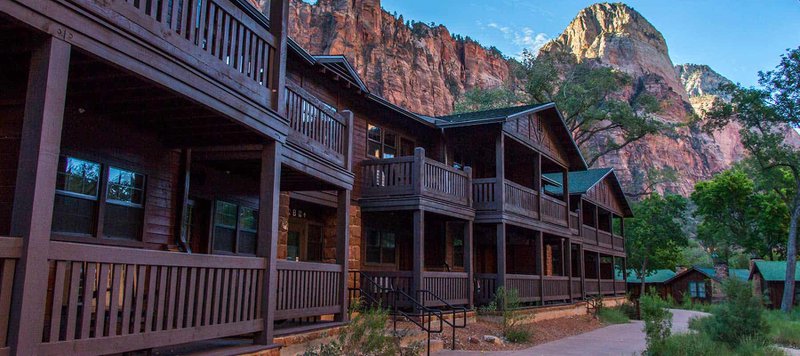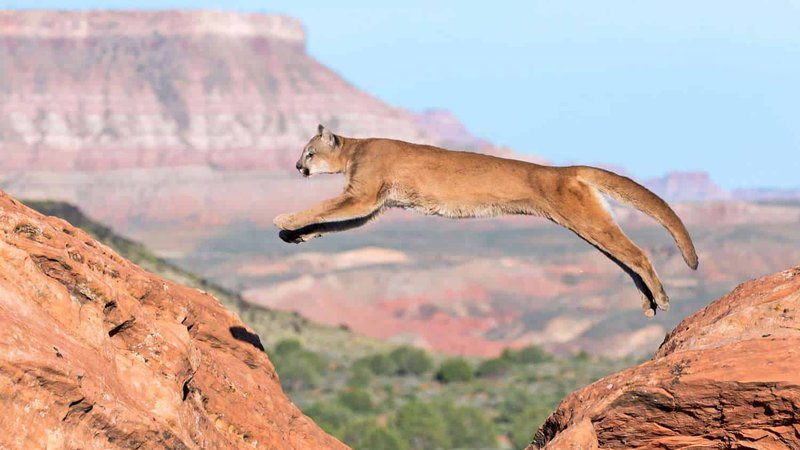The Ultimate Guide For Visiting Zion National Park

Zion National Park is popular for its sandstone cliffs, canyons, and unique formations. It’s in Utah and attracts millions each year for hiking and nature. In fact, the park has gotten so popular in the last few years you now need to have permits to hike certain trails. It is highly advised that you reach out to the park services to reserve your sport before getting to the park. The park has rich history and diverse wildlife, making it a must-visit. This article will cover history, highlights, and essentials for visiting Zion National Park visit. We’ll also highlight the best hikes, accommodations, and safety tips to ensure a memorable and safe trip to Zion. rvResortScout strives to have the most up-to-date articles covering all the National Parks within the United States. Continue to check back for an updated list of National Park reviews the team has done.
For a condensed view of the park feel free to check out rvResortScouts Zion National Park Information listing.
Park History / General Overview
Zion was established in 1919, making it one of the oldest national parks in the United States. It is located in southwestern Utah and covers over 147,000 acres of land. The park contains unique geology, including towering sandstone cliffs, winding canyons, and a variety of rock formations. So we highly suggest having your camera ready to capture all the amazing sites.
Additionally, the park’s human history dates back over 8,000 years, with evidence of Native American cultures found throughout the area. The Ancestral Puebloans were some of the first inhabitants of the region, and their influence can be seen in the park’s many petroglyphs and artifacts.
European explorers arrived in the 1700s. By the late 1800s, settlers came for fertile soil and water. In the late 1800s and early 1900s, people built railroads and developed tourism, transforming the region.
The park’s name, Zion, comes from the Mormon pioneers who settled in the area in the mid-1800s. They believed that the region was a place of refuge, and they named the area Zion, which means “a place of peace and safety.”
Over the years, the park has gone through many changes. These include the construction of roads and trails, the establishment of visitor centers and campgrounds, and the designation of new wilderness areas. Despite all these changes, Zion National Park remains a popular destination for tourists and outdoor enthusiasts from around the world. It offers an unparalleled glimpse into the natural history and beauty of the American Southwest. If you are a history buff this is a park you must visit. Not only will you learn about the ancient tribes that lived in the area. But you will also learn about the intriguing geological history that created Zion.
Getting Oriented
Zion National Park is divided into three main areas: the Zion Canyon, Kolob Canyons, and the East Side. Visitors can access the park via shuttle bus, private vehicle, or bicycle, depending on the time of year and the availability of parking. For those of you wondering “Can You Drive into Zion National Park” we have crafted an article that answers that very question. Sneak peek, the answer is yes. During peak season, the park’s preferred transportation method is the shuttle bus. It helps reduce traffic congestion and protects the park’s natural resources.
The park has several visitor centers, including the Zion Canyon Visitor Center, the Kolob Canyons Visitor Center, and the Zion Human History Museum. These centers offer a wealth of information about the park’s geology, flora, fauna, and human history, as well as maps, exhibits, and interactive displays.
The park’s trails are well-marked and range from easy strolls to challenging hikes. Visitors should research and prepare for their chosen trail, as many of the park’s hikes can be strenuous and require appropriate footwear and water.
Check out our article on How to Get into Zion National Park for more information.
Park Essenitals
During your Zion National Park visit, it’s important to know the essential information to ensure a safe and enjoyable trip.
Getting to the National Park is relatively easy, as it is located just 160 miles from Las Vegas and 300 miles from Salt Lake City. Visitors can drive to the park using Interstate 15 or take a shuttle bus from nearby towns like Springdale, St. George, and Cedar City.
Before entering the park, visitors should be aware of the park’s rules and regulations. These include restrictions on pets, smoking, and drones, as well as guidelines for camping and hiking. Visitors should also be aware of the park’s entrance fees, which vary depending on the type of vehicle and the length of stay.
The Zion Canyon Visitor Center is the best place to start when visiting the park, as it offers a wealth of information about the park’s facilities, services, and activities. Visitors can obtain maps, permits, and backcountry camping information at the center, as well as attend ranger-led programs and watch park orientation films.
Check out The Top 10 Attractions at Zion National Park to see some of the most popular activities within the park.
Visiting Zion National Park: Things to Do
When planning a trip to Zion, several things should be kept in mind to ensure a safe and enjoyable visit. Remember, everyone’s trip will be slightly different. Make sure you pack items that are needed for you and your family.
What to Pack
Packing the right gear is essential for a safe and enjoyable visit. This includes sturdy footwear, layers of clothing for varying temperatures, sun protection, and plenty of water. Visitors should also bring along a backpack to carry essentials like snacks, a first aid kit, and a map. All of this information is essential to having a safe and fun trip when visiting Zion National Park.
Amount of Food Needed
Visitors to Zion should bring enough food for the duration of their visit, as there are limited dining options within the park. Visitors can bring their own food and use the park’s picnic areas, or dine at one of the park’s restaurants, such as the Zion Lodge or the Red Rock Grill. These spots can get busy during the day, so be sure to call ahead and place a reservation. We suggest getting their early and beating the crowds.
Hiking Gear
Appropriate hiking gear is important for a safe and enjoyable hike in Zion National Park. Visitors should wear sturdy footwear and consider bringing along trekking poles and a backpack. In addition, visitors should be aware of the length and difficulty of their chosen hike and prepare accordingly.
Animals In The Area
You may encounter a variety of animals, including deer, bighorn sheep, and rattlesnakes. It’s important to keep a safe distance from wildlife and never feed or approach them.
Cost of Trip
The cost of a trip to Zion can vary depending on factors such as lodging, transportation, and activities. Visitors should budget for entrance fees, camping or lodging fees, and any activities they plan to participate in.
Family Activities
There are several family-friendly activities, such as ranger-led programs, Junior Ranger activities, and hiking trails suitable for children.
Conservation Efforts in Zion National Park
Conservation is an important aspect of visiting Zion. Therefore, visitors should take care to minimize their impact on the park’s natural resources, including packing out all trash and staying on designated trails. You can check out the parks conservation efforts on their National Park Service sustainability page.
RV Do’s and Don’ts
If traveling by RV, visitors should be aware of the park’s restrictions on RV length and be prepared for limited RV parking options. Visitors should also be aware of generator use restrictions and proper disposal of waste water.
Best Hikes Within Zion National Park

Visiting Zion National Park offers a variety of hiking trails with stunning views and unique features. Here are five of the best hikes in the park:
- The Narrows – This hike is unique in that it takes place in a slot canyon with walls towering up to 1,000 feet tall. Hikers can wade through the Virgin River and admire the surrounding rock formations. You can also spot some amazing wildlife if you’re lucky enough.
- Angels Landing – This challenging hike offers stunning views from the top of a narrow ridge with steep drop-offs on both sides. Hikers will navigate a series of switchbacks and chains to reach the summit.
- Observation Point – This trail offers a less crowded alternative to Angels Landing, with similarly breathtaking views. Hikers will climb steep switchbacks to reach the top of the canyon.
- Emerald Pools – This family-friendly hike offers views of sparkling waterfalls and lush vegetation. Hikers can choose from a variety of trails, ranging from easy to moderate.
- The Subway – This strenuous hike is for experienced hikers, as it requires a permit and technical canyoneering skills. Hikers will navigate through a winding slot canyon with unique rock formations and water features.
Accommodations

Zion National Park offers a variety of accommodation options for visitors, ranging from camping to lodges. Here are some of the options:
- Camping – There are three campgrounds within the park that offer tent and RV camping. Visitors can make reservations in advance or try for first-come, first-served spots. But rvResortScout highly suggests making reservations.
- Lodges – The Zion Lodge is the only lodge within the park and offers a range of room types, from cabins to suites. Visitors can also find a variety of lodging options in nearby towns.
- Backcountry Camping – For those looking for a more remote camping experience, backcountry camping is available with a permit. To get to these sites, a strenuous hike is required. You must also come completely prepared.
- RV Parks – There are several RV parks located outside the park that offer full hookups and amenities like laundry facilities and swimming pools. However, there are no RV parks within Zion. You can check out Sand Hollow RV Resort for an amazing RV experience.
Visitors should be aware of park regulations and plan ahead for their accommodations, as availability can vary depending on the season. It’s also important to be aware of wildlife and take precautions to keep food and other items secure.
Safety In Zion National Park

When visitng Zion National Park, visitors should always prioritize their safety while enjoying the park’s natural beauty. Here are some important safety tips to keep in mind:
- Stay on designated trails – Going off-trail can be dangerous and cause damage to the fragile ecosystem. Additionally, hikers can get lost and be left in a life-threatening situation.
- Be aware of weather conditions – Flash floods, lightning strikes, and extreme temperatures can all pose a threat to visitors. Check the forecast and plan accordingly.
- Stay hydrated – Bring plenty of water on hikes and drink regularly to avoid dehydration.
- Watch out for wildlife – Visitors should be aware of potential encounters with wildlife and keep a safe distance.
- Pack appropriate gear – Visitors should have appropriate footwear, clothing, and gear for their chosen activities.
- Follow park regulations – Adhere to park regulations and rules, including those related to camping, fires, and food storage.
- Use caution near drop-offs – Several popular hikes in the park have steep drop-offs that can be hazardous. Stay on designated paths and use caution.
By prioritizing safety and following park regulations, visitors can enjoy their time in one of Utahs most visited National Parks while minimizing risk. In case of an emergency, visitors should know the location of the nearest emergency services and follow park staff’s instructions.
What’s In The Surrounding Area
Zion National Park is situated in southwestern Utah, which is a region renowned for its natural beauty and diverse range of geological formations. There are many other places of interest in the surrounding area that visitors can explore and enjoy.
Additionally, Bryce Canyon is a fascinating geological wonderland featuring towering hoodoos and vibrant rock formations. The park boasts several scenic drives, trails, and viewpoints that provide visitors with stunning vistas of the park’s unique geological features, making it one of the most popular nearby attractions located about 80 miles away from Zion.
Another nearby attraction is the Grand Staircase-Escalante National Monument, which is located about 40 miles from Zion National Park. The monument is a vast wilderness area covering nearly 1.9 million acres of diverse terrain, including canyons, plateaus, and rugged desert landscapes. There are many hiking trails that visitors can explore, including the popular Lower Calf Creek Falls hike, which features a 126-foot waterfall.
In addition to Bryce Canyon and Grand Staircase-Escalante, there are several other nearby attractions that visitors may want to check out. These include Cedar Breaks National Monument, which is located about 50 miles from Zion and features colorful rock formations and breathtaking views, and the town of Springdale, which is located just outside of Zion and offers a range of dining, shopping, and lodging options for visitors.
Visiting Zion National Park: Wrap Up
In conclusion, Zion is a unique and awe-inspiring destination that offers something for everyone. From its breathtaking vistas to its challenging hiking trails, visitors will find a wide range of experiences to enjoy. By planning ahead, following park regulations, and prioritizing safety, visitors can make the most of their time in this natural wonder.



jonathan.cano004
June 3, 2023 at 2:45 pmWhat’s the next closest park near this one?
David Gonzalez
June 4, 2023 at 2:00 pmExcellent question! The closest National park to Zion National Park is Bryce Canyon National Park.